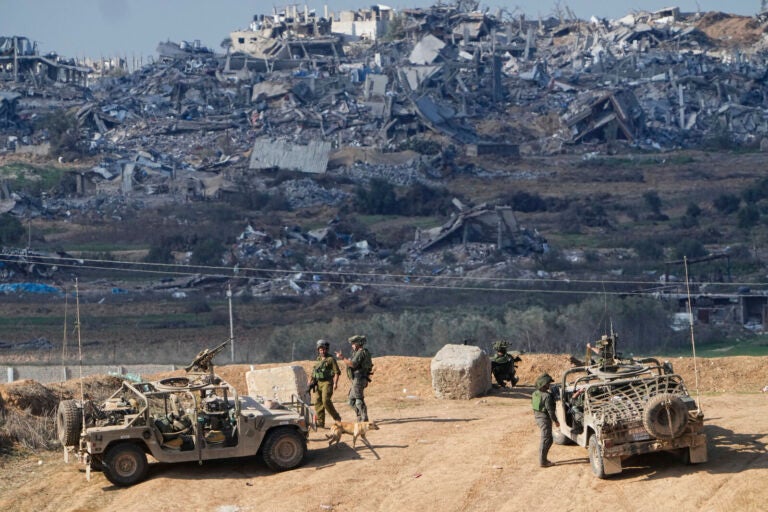The catastrophe in Gaza after 100 days of Israel-Hamas war, by the numbers

In the 100 days since the Israel-Hamas war began, the destruction in Gaza has been catastrophic. (Ariel Schalit/AP)
The numbers that capture the state of Gaza after 100 days of war are staggering: Nearly two million displaced, thousands of homes destroyed and nearly 24,000 dead — 10,000 of them children.
Since the outbreak of war on Oct. 7, when the militant group Hamas broke into southern Israel and killed 1,200 people and kidnapped some 250 more, the toll of Israel’s response on Gaza, which is governed by Hamas, has been catastrophic for the territory.
“What we have seen since 7 October is a stain on our collective conscience. Unless we act, it will become an indelible mark on our humanity. People will continue to suffer and die from the rockets, the bombs, the missiles and the bullets; and in increasing numbers from starvation, disease and exposure,” the United Nations humanitarian chief Martin Griffiths said Friday.
23,938 dead and 60,582 injured
The death toll, updated regularly by the Palestinian Ministry of Health, does not distinguish between civilians and combatants. But about 70% of the dead are women and children, the ministry says. About 10,000 of the dead are children under the age of 18. Nearly 8,000 more are reported to be missing, presumed dead under rubble.
In other words, more than one percent of Gaza’s pre-war population of 2.3 million have been killed in just over three months of conflict.
The health ministry also tracks injuries. Hospitals have reported catastrophic injuries caused by airstrikes, including severe, full-body burns and crushed limbs. About 1,000 children have lost one or both legs, the aid group Save The Children said this week.
“An entire generation of children is traumatized and will take years to heal. Thousands have been killed, maimed, and orphaned. Hundreds of thousands are deprived of education. Their future is in jeopardy, with far-reaching and long-lasting consequences,” said Philippe Lazzarini, the commissioner-general of UNRWA, the U.N. agency in Gaza, in a statement Saturday.

1.9 million people displaced
About 85% of Gaza’s population have been forced out of their homes to flee conflict in the largest displacement of Palestinian people since the wars that surrounded the founding of Israel in 1948, UNRWA says.
Many families have now been displaced more than once. Israel’s ground operations initially focused in the northern part of the territory, and ahead of its ground invasion in October, Israel had urged Palestinians in Gaza City to evacuate to the south. But its airstrikes have repeatedly pummeled the south, too.
Over the past month, Israel’s ground operations have refocused on cities in central and southern Gaza, including Khan Younis, forcing Palestinians to flee once again. Now, an estimated 1.3 million people have crowded into Rafah, the city closest to Gaza’s southern border with Egypt.
“We don’t know where to go or what to do. We’re going from spot to spot,” said a man who called himself Abu Ibrahim Sharran, as he rode a bicycle loaded with a sleeping mat and clothes on the streets of Khan Younis earlier this month.
His family had already evacuated twice, he said, and he was looking for yet another place to stay. “May God provide relief for everyone, so that people will be able to return to their homes, instead of sitting scattered on the streets.”
As many as 160,800 buildings damaged or destroyed
The scale of destruction is beyond a scale ever seen in Gaza, especially in Gaza City, which has drawn comparisons to the worst bombardments of world conflicts in recent history, including Mariupol in Ukraine and Aleppo in Syria.
Perhaps the best estimate of the scale of destruction comes from satellite imagery. According to an analysis of satellite imagery by researchers at Oregon State University and the City University of New York, as many as 55.9% of all buildings in the Gaza Strip have been damaged or destroyed by Israel’s bombardment, or up to 160,800 buildings.
In northern Gaza, where most of the territory’s residents lived before the war, the numbers are even higher: Researchers estimate that up to 80% or more of buildings have been damaged or destroyed.

21 out of 36 hospitals out of operation
The World Health Organization reports that less than half of the hospitals in Gaza are operating at any capacity. And at those that are operational, bed capacity is estimated to be at 351%, the WHO reports — in other words, hospitals in Gaza are treating more than three times the number of patients for which they are equipped.
Hospitals and medical staff in Gaza have reported shortages of practically everything needed to treat the massive number of wounded and sick. Medical supplies of all kinds are in short supply, including antibiotics, first aid supplies, IV fluids and blood. Electricity has been a major challenge for hospitals since Gaza’s main power plant went offline early in the war; hospitals have been desperate for fuel to operate generators needed to power ventilators, incubators and other health equipment reliant on electricity.
“There are no beds available, so people are literally just on the ground, seeking treatment. There’s not really room or space for us to breathe or think,” said Dr. Seema Jilani, an American doctor who spoke to NPR after two weeks working at Gaza’s al-Aqsa Hospital as part of a team from the International Rescue Committee.
More than 600 healthcare workers have died in attacks and nearly 800 more have been injured, according to the WHO. Dozens of ambulances have been damaged.
9(MDAzMzI1ODY3MDEyMzkzOTE3NjIxNDg3MQ001))




